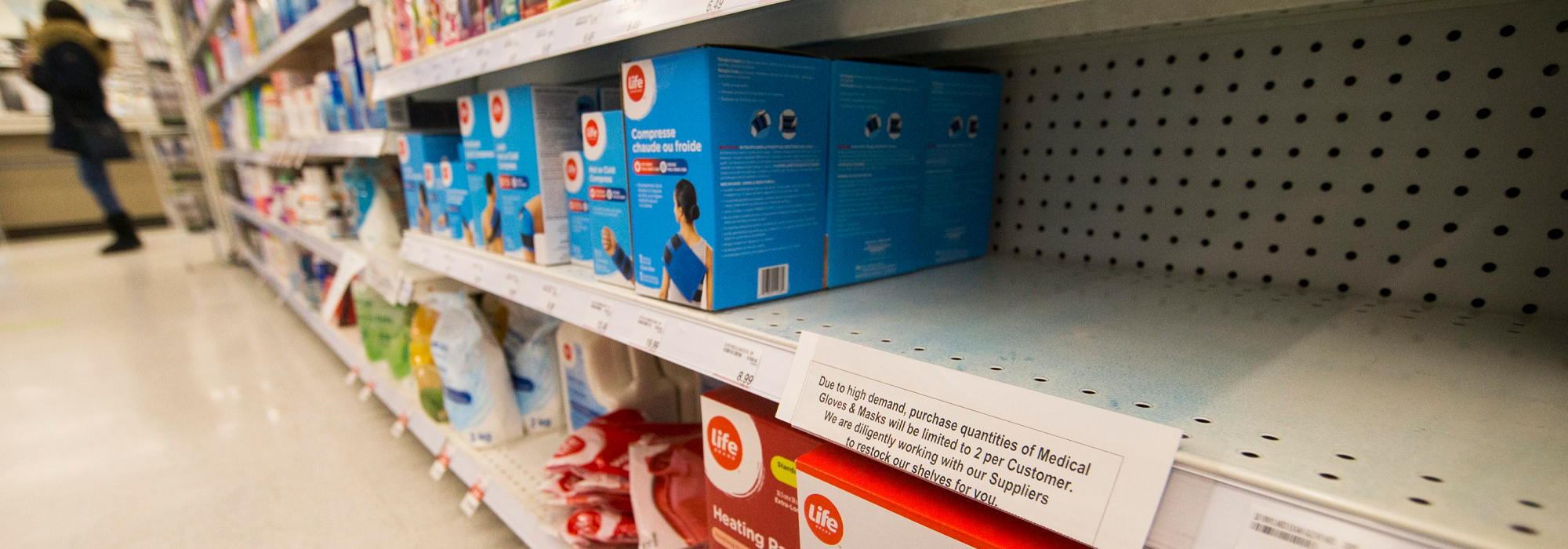
The panic in Canada over the lack of masks and ventilators for COVID-19 has mostly eased, but it would be foolish to let the memory and lessons of those scary first few weeks fade too quickly. The scramble for medical equipment was actually a critical moment for the Canadian economy, because it revealed something alarming, something we should all be focused on.
We don’t know if we can produce what we need in a crisis.
In the last two decades, we have been lulled into following a rapid path of offshoring – that is the transferring of production to other countries. The huge short-term profits of this trend, coupled with impressive decreases in the prices of certain consumer goods, soothed us. For many, green arrows and highlights on smartphone investment tracker apps – indicating that stock prices were continuing to rise – provided an illusion that all was well in the economy.
It wasn’t.
We were the mythical frog floating in a pot of water on the stove, slowly being boiled alive without realizing it. We lost sight of the critical requirements of a vibrant economy – one of which is good jobs. The unfolding COVID-19 crisis exposed Canada’s and the West’s significant economic and security vulnerabilities. We no longer produce – indeed, we are not even able to develop – many of the things we need to run a modern, prosperous economy.
From swabs, facial masks, drugs and ventilators to simple computers and advanced 5G telecommunication products, we are largely dependent on overseas suppliers. The supply networks that underpin both the production and innovation of those goods long ago moved from North America to Greater China. That exodus left us with hollowed-out capabilities, broken production capacities, under-utilized engineering and technical talent and over-reliance on one relatively small region of the world.
The pandemic might be our last opportunity to regain prosperity. COVID-19 represents a sudden burst of heat that should awaken us to the fact that we are being cooked alive. Nonetheless, let us be clear: We are already well cooked, having already lost so much productive capacity that reviving our economy will require us to overcome significant challenges, and then sustain those efforts over many years – even as the pandemic recedes to the background.
This we must do. Not only is our long-term prosperity at stake, but also because the next crisis disrupting our global production chains is already around the corner, be it medical, natural, political or human-made.
Strategy for Action
There are two critical spheres of action. First, dealing with the managerial and financial regulations and incentives that have made offshoring the rational, and sometimes only, option. Second, engineering a response to rebuild our depleted production capacities. This means skills to production networks of suppliers and sub-suppliers that will allow us to both produce and innovate in producing finished products.
We should not expect public companies to stop moving production to foreign countries without changing the financial incentives of both managers and investors. That requires a fundamental shift away from focusing on short-term stock prices utilizing financial engineering tools. This includes stock buybacks and the use of a complex network of offshore companies (Double Irish with a Dutch Sandwich, anyone?). Further, we must move beyond worshiping performance metrics such as simplified return-on-assets, which incentivize moving as many holdings off balance sheets as possible.
After two decades of accelerated offshoring, the obstacles to reshoring are currently so significant, we should not assume that even our best-run corporations can overcome these financial obstacles by themselves. In order for a high-end manufacturer to produce, it needs a constant supply of two things: components, from screws and pins to various sub-systems; and technicians, engineers and managers with highly honed production skills. It also needs to be assured that there will be stable demand for its outputs.
Canada is severely lacking in all.
The road to stable demand
We need to acknowledge the obstacles and figure out how to solve them, collectively.
The first obstacle is ensuring demand, and not just a momentary peak demand. Rather, it must be stable, long-term demand. Without long-term demand for domestically produced products and components, companies, managers and workers will not invest in building production-capacity or acquiring and honing the necessary skills.
How then can we ensure a minimal level of stable demand for Canadian-produced products, sub-systems and components?
The first tool should be government purchasing – at all levels, municipal, provincial and federal. All purchasing should include a “Made in Canada” component in all sectors and industries. Additionally, companies that are given government aid as part of the COVID-19 response should be required to move and sustain a minimal (but economically significant) percentage of their sourcing and production back to Canada. This should be done in both direct government procurement programs as well as through authorizing reimbursement programs such as medicine.
A key challenge is defining “Made in Canada.” The situation is even murkier for products such as pharmaceuticals, where so-called Canadian drugs are made with 100-percent Chinese and Indian-manufactured active ingredients.
What’s clear is that better measurement and disclosure are necessary. Industries should disclose how much critical production actually takes place in Canada. With the right branding, consumers would be willing to pay a premium on such products, both for quality and moral (for example fair-trade) reasons.
Further, it should be illegal for producers to claim anything that implies that they are, by using misleading labels such as “Proudly Canadian,” or “A Canadian Tradition,” without a significant percentage of all components and sub-systems (and not just final assembly) actually produced in Canada.
Disclosure would also create opportunities for exclusive branding, allowing such products to fetch a higher price, as has been aptly demonstrated by both moral branding, such as fair trade in food, or quality, along the lines of “Made in Germany” for well-engineered goods such as washing machines, or “Made in Italy or France” for food and luxury items. Just think for a moment about the significant price differences in basic food staples that claim to be GMO-free and imagine the price premium that consumers would be willing to pay for foreign-made active ingredients-free drugs.
Often the problem is not one of absolute demand, but fragmented demand. This makes it difficult to match existing demand with supply. With its large land mass, multiple local markets and competing and baffling provincial regulations, Canada is especially prone to such problems. Government policy can easily solve this issue by mapping out and aggregating demand, then promoting it. Just demonstrating there is significant demand to be tapped in Canada will change the investment rational of most companies, investors and entrepreneurs.
Protecting Canadian ingenuity
Canada currently runs a large trade deficit in even its most advanced technologies. Even worse, many of our greatest inventions leave Canada for greater China and the US almost as soon as they are invented at Canadian universities. Ensuring that our innovators can successfully grow in Canada during the early stages of company development, is essential if we ever want to grow vibrant industrial eco-systems.
The second prong in infant production technology protection should be legal covenants. These can prevent the transfer of those technologies abroad for at least a decade, thus ensuring that all Canadian taxpayers, who after all paid for their development, also enjoy the prosperity they generate. Israel is an example. The Israeli Innovation Authority has the legal, contractual and enforcement capacity to ensure that any IP developed in projects it supported stays in that country.
Bridging the skills gap
The second obstacle to reshoring is skills. Here, the problem is not just shop-floor production skills, but also system, production and tooling engineering and production management. Add to the mix investment skills needed to grow, develop and sustain organizations that produce, instead of organizations that outsource and manage offshore supplier networks.
These skills are not gone – not yet. They exist, in isolated pockets across Canada, and among many industrial retirees – either forced or voluntary. While apprenticeship programs ought to be expanded, we also need training programs that diffuse skills residing in the heads and hands of the remaining pool of skilled and experienced workers.
Additionally, we should be targeting skilled retirees (or workers that have been displaced due to offshoring) to serve as mentors and instructors to new productions facilities across the nation. Many of those highly skilled people will gladly devote their time and knowledge to help Canada prosper again.
It is also our time to learn from China. During the many years doing field work in China with my coauthor Michael Murphree, we were struck by how well local planners in the Pearl River Delta understand production. They also understood the key role played by the local supply chain in ensuring innovation and continued economic growth and prosperity. City and regional leaders recognize the need for collective goods and coordination. To provide both, they continuously map their local supply chains, identifying gaps and skills, components and knowledge, and boldly act to bridge them.
This is exactly the role local policy makers should play: coordination, support and ensuring collective action to supply public and semi-public goods companies cannot provide by themselves. Chinese policy makers mapping and sustaining local supply networks have been instrumental in building and sustaining China’s impressive production system. It is high time we learn from them.
Last, but not least, are production research intermediaries – organizations that specialize in two critical domains for advanced production. First, they help transform and translate academic research into practical production technologies and solutions. Second, their contributions become the first cohort of engineers who work in and with those technologies. This approach is widely used around the world, including Germany’s Fraunhofer-Gesellschaft and Taiwan’s Industrial Technology Research Institute. While there has been widespread interest in their research translation functions, the mechanisms for suppling high-skilled production talent is significantly underappreciated.
Last chance to act
COVID-19 has brutally exposed our weaknesses. Fortunately, it did so just before our frog was boiled to death. The task in front of us is difficult and will take years to bear fruit. However, the pandemic gives us one last chance to secure prosperity for the future generations of Canadians, as well as ensuring that the next crises will not find us so vulnerable. It is time then, that we believe again in Canadian ingenuity and give Canadians the chance to show the world what its people are capable of doing.
Let us all take collective leadership and action in shaping our future for the better.
This article is part of the Building a More Inclusive Innovation Economy After the Pandemic special feature.










